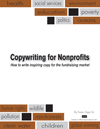Any day of the week I can glance over tweets from nonprofits – charities and associations – and find examples of how not to write tweets for donors and prospects.
Today I pulled three examples from my collection of “less than ideal tweets” to share. I didn’t research the charities to learn more about what they’re promoting. But even without taking time to do that it’s possible to write stronger tweets.
1) In case you need a how-to: RT @nsenger 8th graders assembling @CatholicRelief rice bowls http://bit.ly/mfjCFf
That tweet was by @CatholicRelief
Follow that link and you’ll come to a page with a photo and no caption, no explanation, nothing.
The tweet says, “In case you need a how-to…” Hmmm. Where’s the “how-to” information? What are we supposed to learn from this?
Questions that come to mind include: How will the rice bowls be used? How did they get the kids involved? Will they let the kids know how the rice bowls were received, appreciated, and used through follow-up stories and photos?
More donor-centric: On the landing page answer the questions I posed in the previous paragraph. This would go a long way toward encouraging more people to duplicate what these 8th graders are doing. Rarely is a stand-alone photo enough. Images are great. They’re even better augmented with informative and passionate copy. Assuming the landing page is improved, here’s a suggestion on how to rewrite the original tweet …
8th graders assemble @CatholicRelief rice bowls to feed families. See how your school or parish can do the same http://bit.ly/mfjCFf
2) Check us out on facebook at http://bit.ly/j9xBrj
That tweet was by @kidneyregistry
I’m all for sending people to Facebook. Just tell me WHY I should do it? What neat story will I find? Why should I spend time doing this and what will I find?
More donor-centric: This one is challenging to rewrite because the link takes us to a generic page. One suggestion is to focus on a specific story and take them to a page with that story…
Read how a stranger – Judith from Michigan – donated a kidney to save a life, and how she feels after doing it … [insert link which could take people directly to the story on Facebook]
3) Ivory Coast: Displaced families – in pictures…+200,000 people face health ‘catastrophe’ as rainy season approaches. http://bit.ly/kITMk5
That tweet was by @wrcommission (Women’s Refugee Commission)
Here in my blog and other places I’ve often advised that a HUGE number like 200,000 is daunting to donors. They think, “How can I possibly help that many people? My $10 or $25 won’t begin to help.” So I recommend you focus on a single family. Donors can understand that.
Another significant weakness of this tweet is that the link takes you to a news article (within an online newspaper and not on the nonprofit’s website). Furthermore the article mentions “Save the Children” and not the Women’s Refugee Commission.
More donor-centric: It’s possible that the Women’s Refugee Commission (WRC) somehow supports Save The Children. I don’t know. And I also don’t know what WRC was trying to accomplish by sharing the information from the news article.
Nonetheless a possible new approach would be to summarize the highlights of the news article on a landing page within the WRC website. Have a specific call to action on the page showing how donations of various amounts could help a family or two stricken by the problem. Within the summary have a link to the news site and attribute the source. With that in mind a tweet could read …
Refugee mother and 3 children need shelter from rainy season to avoid serious illness. Your $25 keeps them safe and dry [insert link]
REMEMBER: Your tweets can and almost certainly will be seen by people who do NOT follow you. True prospects.
So as you write donor-centric tweets, bear in mind that prospects don’t know a thing about you, and donors remember a small fraction of the details about your organization. They don’t know as much as you even if you’ve told them about it in the past.
Therefore don’t write tweets assuming a wealth of knowledge. These tweets will fall flat and leave people wondering, “What in the world are you talking about?”
Social media is a marvelous way to cultivate donors, and to draw in prospects. But it only works if you write donor-centric copy and not vague or self-centered copy.
Any examples you would like to share? Either nonprofit tweets done right, or those that could be better? Please share in the comments below.
Related posts:
Crank up the Facebook heat … writing more donor-centric updates for Facebook
How “aspiration” benefits your nonprofit … copywriting insights so your message resonates with readers

{ 2 trackbacks }
{ 2 comments… read them below or add one }
This is a great post – I love your samples of great tweets, and they are spot on. It is so easy working at a nonprofit to get tunnel vision and write all your copy from the nonprofit’s point of view. But it’s critical to switch your thinking and write from your donor’s point of view. It’s the only way you’ll write successful messaging!
Hi Chapin,
Thanks for your kind words and comment. I see you’re with the nonprofit, ProKids (http://ProKidsOnline.org). I think golf is an excellent way to help underpriviledge kids learn values and get a chance for positive team play. It’s a game/sport they can enjoy for their entire life.
Do you have any examples of tweets on behalf of ProKids to share?